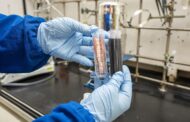
This first computational model to simulate multiple antenna proteins, photosystem II (PSII) complexes are shown in teals, and light harvesting complexes (LHC II) are shown in green.
Berkeley Lab Researchers Create First Multiple Antennae Model of Photosystem II
To understand what goes on inside a beehive you can’t just study the activity of a single bee. Likewise, to understand the photosynthetic light-harvesting that takes place inside the chloroplast of a leaf, you can’t just study the activity of a single antenna protein. Researchers with the U.S. Department of Energy (DOE)’s Lawrence Berkeley National Laboratory and the University of California (UC) Berkeley have created the first computational model that simulates the light-harvesting activity of the thousands of antenna proteins that would be interacting in the chloroplast of an actual leaf. The results from this model point the way to improving the yields of food and fuel crops, and developing artificial photosynthesis technologies for next generation solar energy systems.
The new model simulates light-harvesting across several hundred nanometers of a thylakoid membrane, which is the membrane within a chloroplast that harbors photosystem II (PSII), a complex of antennae made up of mostly of chlorophyll-containing proteins. The antennae in PSII gain “excitation” energy when they absorb sunlight and, through quantum mechanical effects, almost instantaneously transport this extra energy to reaction centers for conversion into chemical energy. Previous models of PSII simulated energy transport within a single antenna protein.
“Our model, which looked at some 10,000 proteins containing about 100,000 chlorophyll molecules, is the first to simulate a region of the PSII membrane large enough to represent behavior in a chloroplast while respecting and using both the quantum dynamics and the spatial structure of the membrane’s components,” says chemist Graham Fleming, who oversaw the development of this model. Fleming is a world authority on the quantum dynamics of photosynthesis. He holds appointments with Berkeley Lab, the University of California (UC) Berkeley, and the Kavli Energy NanoScience Institute at Berkeley.
“We use insights from structural biology, advanced spectroscopy and theory to reproduce observed phenomena spanning from one nanometer to hundreds of nanometers, and from ten femtoseconds to one nanosecond,” Fleming says. “This enables us to explain the mechanisms underlying the high quantum efficiency of PSII light harvesting in ideal conditions for the first time.”
Fleming is the corresponding author of a paper describing this research in the Proceedings of the National Academy of Sciences. The paper is titled “Multiscale model of photosystem II light harvesting in the thylakoid membrane of plants.” Co-authors are Kapil Amarnath, Doran Bennett and Anna Schneider.
The ability of green plants to thrive in sunlight stems in part from the flexibility that PSII displays in harvesting solar energy. At low levels of light, through quantum processes that have been modeled by Fleming and coworkers, a photon of sunlight can be utilized for creation of chemical energy with more than 90-percent probability. Thanks to a protective mechanism known as “energy-dependent quenching,” PSII is able to ensure that a plant absorbs only the amount of solar energy it needs while excess energy that might damage the plant is safely dissipated.
Earlier work by Fleming and his research group revealed a molecular mechanism by which PSII is able to act as a sort of photosynthetic “dimmer switch” to regulate the amount of solar energy transported to the reaction center. However, this work was done for a single PSII antenna and did not reflect how these mechanisms might affect the transport of energy across assemblies of antennae, which in turn would affect the photochemical yield in the reaction centers of a functional thylakoid membrane.
“Our new model shows that excitation energy moves diffusively through the antennae with a diffusion length of 50 nanometers until it reaches a reaction center,” Fleming says. “The diffusion length of this excitation energy determines PSII’s high quantum efficiency in ideal conditions, and how that efficiency is altered by the membrane morphology and the closure of reaction centers. Ultimately, this means that the diffusion length of this excitation energy determines the photosynthetic efficiency of the host plant.”
Given that the ability of PSII to regulate the amount of solar energy being converted to chemical energy is essential for optimal plant fitness in natural sunlight, understanding this ability and learning to manipulate it is a prerequisite for systematically engineering the light-harvesting apparatus in crops. It should also be highly useful for designing artificial materials with the same flexible properties.
Read more: Seeing the Big Picture in Photosynthetic Light Harvesting
The Latest on: Photosynthetic Light Harvesting
[google_news title=”” keyword=”Photosynthetic Light Harvesting” num_posts=”10″ blurb_length=”0″ show_thumb=”left”]
via Google News
The Latest on: Photosynthetic Light Harvesting
- New dataset sheds light on relationship of far-red sun-induced chlorophyll fluorescence to canopy-level photosynthesison April 25, 2024 at 12:25 pm
In recent years, the scientific community has increasingly turned its attention to sustainable agriculture, aiming to maximize crop yield while minimizing environmental impact. A crucial aspect of ...
- Scientists released long-term data of ground solar-induced fluorescence to improve understanding of canopy-level photosynthesison April 24, 2024 at 5:00 pm
A recent study utilized ground-based instruments to measure solar-induced fluorescence (SIF) that reflect plant health and photosynthesis.
- Light and Photosynthesis in Aquatic Ecosystemson April 22, 2024 at 4:59 pm
As we have seen (Chapter 6) the irradiance decreases with depth from intensities that are so high as to be damaging down to levels that cannot support photosynthesis, and the spectral distribution of ...
- Plants cleverly adapt their photosynthesis to changes in lighton April 9, 2024 at 8:00 am
Recent research sheds light on how plants manage these shifts, revealing a communication system that lets them adjust their photosynthesis ...
- How plants adjust their photosynthesis to changing lighton April 7, 2024 at 5:00 pm
Photosynthesis is the central process by which plants build up biomass using light, water, and carbon dioxide from the air. Gaining a detailed understanding of this process makes it possible to ...
- Heterogeneous ultrafast relaxation in photosynthetic light-harvesting proteinson March 26, 2024 at 12:00 am
In photosynthesis, solar energy capture to conversion occurs ... We demonstrate the power of this technique on cyanobacterial light-harvesting subunits. Our experiments reveal heterogeneous timescales ...
- Light and Photosynthesis in Aquatic Ecosystemson March 16, 2024 at 8:37 am
To save content items to your account, please confirm that you agree to abide by our usage policies. If this is the first time you use this feature, you will be asked to authorise Cambridge Core to ...
- Photosynthetic Megacomplex (IMAGE)on June 4, 2022 at 4:15 am
The photosynthetic megacomplex from a cyanobacterium ... It has three parts: on top is a light-harvesting antenna complex called a phycobilisome that captures and funnels the energy in sunlight ...
- Professor Neil Hunter FRSon August 6, 2021 at 12:26 am
Photosynthesis powers life on Earth; it supplies the oxygen we breathe, and it converts waste carbon dioxide into food and fuel. However, sunlight is a diffuse energy source so an extensive ...
- Dealing With the Hazards of Harnessing Sunlighton October 3, 2018 at 4:20 am
Most plants do maintain light-harvesting structures that periodically absorb more light than photosynthesis can utilize, and simply remove the excess energy (see below). As an extreme example ...
via Bing News







